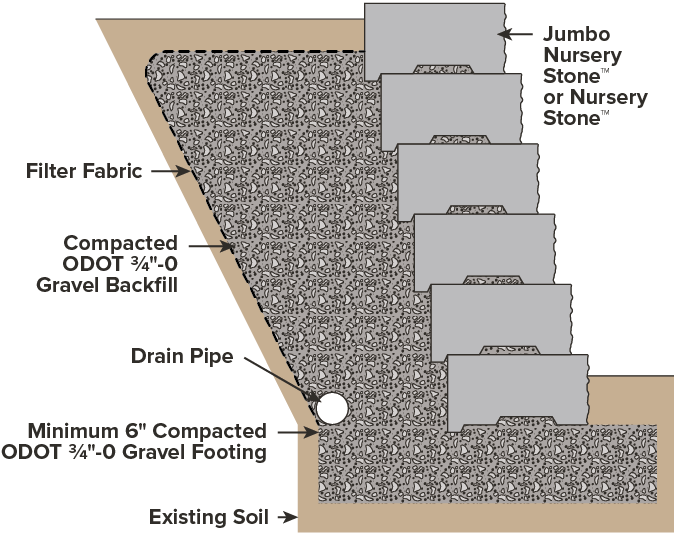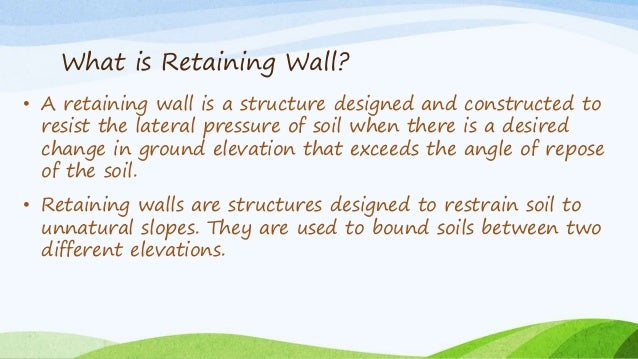About Austin Construction Company
Table of ContentsAll about Construction Company AustinHow Ace Construction Company Austin can Save You Time, Stress, and Money.Not known Facts About Ace Construction Company AustinThe Basic Principles Of Austin Construction Company
Likewise, any groundwater behind the wall that is not dissipated by a drainage system triggers hydrostatic pressure on the wall. The total pressure or thrust might be assumed to act at one-third from the lowest depth for lengthwise stretches of consistent height. It is essential to have appropriate drain behind the wall in order to limit the pressure to the wall's style worth.Drystone maintaining walls are typically self-draining. As an example, the International Structure Code requires retaining walls to be developed to make sure stability against reversing, sliding, excessive foundation pressure and water uplift; which they be designed for a security aspect of 1. 5 against lateral sliding and overturning. Different types of keeping walls Building types of gravity retaining walls Gravity walls depend upon their mass( stone, concrete or other heavy material) to resist pressure from behind and may have a 'batter' setback to enhance stability by leaning back towards the maintained soil.
Dry-stacked gravity walls are rather versatile and do not need a stiff footing. Previously in the 20th century, taller maintaining walls were often gravity walls made from large masses of concrete or stone. Today, taller keeping walls are progressively developed as composite gravity walls such as: geosynthetics such as geocell cellular confinement earth retention or with precast dealing with; gabions (stacked steel wire baskets filled with rocks); baby crib walls (cells constructed up log cabin design from precast concrete or lumber and filled with granular product).
These walls cantilever loads (like a beam) to a big, structural footing, transforming horizontal pressures from behind the wall to vertical pressures on the ground listed below. Sometimes cantilevered walls are buttressed on the front, or consist of a counterfort on the back, to enhance their strength resisting high loads. Buttresses are short wing walls at ideal angles to the primary pattern of the wall.
The 8-Second Trick For Ace Construction Company Austin


For a fast price quote the product is typically driven 1/3 above ground, 2/3 below ground, but this may be altered depending on the environment. Taller sheet pile walls will need a tie-back anchor, or "dead-man" put in the soil a distance behind the face of the wall, that is connected to the wall, usually by a cable or a rod.
Bored pile maintaining wall in Lisbon, Portugal Bored stack keeping walls are constructed by putting together a sequence of bored piles, followed by excavating away the excess soil. Depending on the job, the bored pile retaining wall might include a series of earth anchors, reinforcing beams, soil enhancement operations and shotcrete support layer.
An anchored keeping wall can be constructed in any of the aforementioned designs however likewise includes additional strength utilizing cables or other stays anchored in the rock or soil behind it. Typically driven into the product with boring, anchors are then expanded at the end of look at this site the cable, either by mechanical ways or often by injecting pressurized concrete, which broadens to form a bulb in the soil.
The Single Strategy To Use For Construction Company Austin
Soil nailing is a method in which soil slopes, excavations or retaining walls are enhanced by the insertion of relatively slender aspects normally steel reinforcing bars. The bars are typically installed into a pre-drilled hole and then grouted into place or drilled and grouted concurrently. They are generally installed untensioned at a small downward inclination.
A number of systems exist that do not consist of simply the wall, but minimize the earth pressure acting straight on the wall. These are normally utilized in mix with among the other wall types, though some may only utilize it as dealing with, i. e., for visual functions. Stones of maintaining wall used check this in preventing soil run-off in dale This kind of soil conditioning, frequently also used without an Discover More Here outside wall, consists of wire mesh "boxes", which are filled with roughly cut stone or other material.
Gabion walls are free-draining keeping structures and as such are frequently integrated in areas where ground water exists. However, management and control of the ground water around all keeping walls is essential. Mechanically stabilized earth, also called MSE, is soil constructed with artificial strengthening through layered horizontal mats (geosynthetics) repaired at their ends (austin construction company).
Other choices include steel straps, also layered. This kind of soil reinforcing typically needs outer dealing with walls (S.R.W. austin construction company.'s Segmental Retaining Walls) to affix the layers to and vice versa. The wall face is typically of precast concrete systems that can endure some differential movement. The strengthened soil's mass, in addition to the dealing with, then acts as an enhanced gravity wall.
The 3-Minute Rule for Ace Construction Company

Gravity walls typically need to be a minimum of 50 to 60 percent as deep or thick as the height of the wall, and may need to be bigger if there is a slope or surcharge on the wall. Cellular confinement systems (geocells) are also utilized for steep earth stabilization in gravity and reinforced maintaining walls with geogrids.
The outer fascia cells of the wall can be planted with vegetation to produce a green wall. Ching, F. D., Faia., R., S., & Winkel, P. (2006 ). Building Regulations Illustrated: A Guide to Comprehending the 2006 International Building Regulations (2 ed.). New York City, NY: Wiley. Ambrose, J. (1991 ). Simplified Style of Masonry Structures.
pp (Ace Construction Company). 7075. 0471179884. Crosbie, M. & Watson, D. (Eds.). (2005 ). Time-Saver Standards for Architectural Style. New York, NY: McGraw-Hill. (2011) Commercial Setup Manual for Allan Block Retaining Walls (p. 13) Terzaghi, K. (1934 ). Big Retaining Wall Tests. Engineering News Record Feb. 1, March 8, April 19. 2006 International Building Regulations Section 1806.